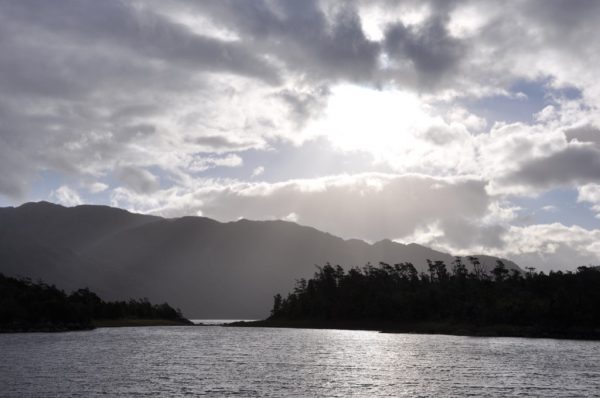Before Our Very Eyes (Amalia Glacier)
Part Five of the Tale of Mollymawk's Expedition from Natales to EdenTilman didn’t think much of Puerto Bueno. For Sarmiento it was “a good port”, for Skyring it was “an excellent haven”, and for Edward Allcard it was “well-named” – but Tilman was unimpressed.
A place which has long figured as the penultimate goal [or] the … springboard into the unknown is often given in one’s mind unwarranted attributes
, says he; and he then explains how various places in the Himalayas which seem, from their position on the map, to be important have turned out to be nothing of the sort: I can think of places … on which for many days the thoughts of the party have fondly dwelt – the sheep, eggs, butter, beer, or transport likely to be available there – only to find on arrival a smoky hovel tenanted, if at all, by an ascetic … who has chosen it as a spot where he will not be tempted … .
Oh dear! What was Tilman expecting? By now, as he says, he and his companions knew full well that a port, in this part of the world, is seldom that which it would be in ours. Then as now, at Puerto Bueno there is no one and nothing. There is not even an ascetic’s hut! Yet this was the place where, after dropping off the mountaineers in the Peel Inlet, Mischief and her crew were to sit and wait for their return. “There seemed to be no life and little of interest in the neighbourhood,” Tilman tells us, and he evidently anticipated that the men who were to be left aboard would have a very dull time in Puerto Bueno. However, he was wrong.
Indeed, he was wrong on both counts…
But of that we shall hear more in a little while.
Puerto Bueno may have been just as Tilman left it – just as even Sarmiento left it – but by the time we reached that inlet, five miles further north, whither Mischief and Mollymawk were both bound, it was clear that something has changed in this vicinity. By the time they rounded the corner and were able to look up the Peel Inlet, Tilman and Co had spotted a large ice-floe aground on one of the islands in the mouth of the channel; and Allcard, passing this way some ten years afterwards, actually saw ice drifting past Puerto Bueno. For us there were no such delights – but in that expression of disappointment I reveal myself to be as naive and foolish as were the crew of Mischief :
“Several more floes, some of fantastic shape and delicate blue colouring now drifted by and were greeted with pleased cries, much as an ignorant clown might greet the first few ranging shots of a hostile battery.”
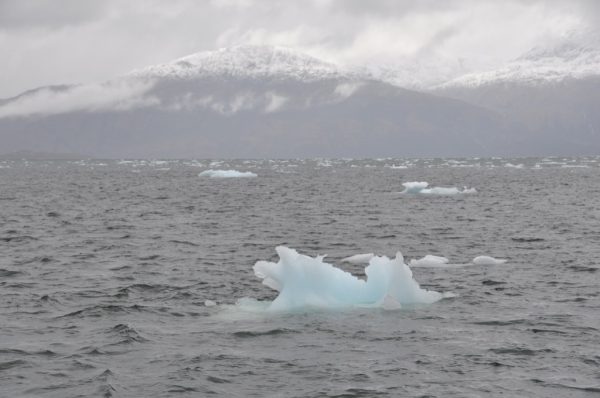
When, shortly afterwards, they saw that the entire channel ahead of them was filled with ice, Tilman and his friends awoke to the fact that they were sailing into troubled waters. The jolly mood evaporated and the mountaineer began to wonder where he might go if the Peel inlet was entirely blocked. Fortunately, as he tells us, “these weak fears, engendered possibly by a diet of mussels, proved groundless.”
With a look-out posted in the bow they were able to wend their way amongst the bergy-bits, sometimes using the boathook to push away what couldn’t be avoided. And at this point I should explain that whereas Mollymawk is constructed of steel and with the possibility of navigating through ice as one of the design criteria, Mischief was an old wooden vessel; she had begun her days as a pilot cutter in the Bristol Channel – that open stretch of water lying between England and Wales – and although she was well-built and strong the chief considerations in her design had been speed and oceanworthiness. Thus when it came to navigating in ice it was a case of, ‘Steady as she goes’.
The Peel inlet has several arms, and the one chosen by Tilman as being most suitable for an assault on the ice-cap was the first. Known as the Estero Amalia, it promised access to a broad glacier which sweeps down from the summit of the Andes. As they opened this arm the glacier came into view. “A huge sheet of ice nearly two miles broad, cleft in the middle by a bald rocky hill”, it made a thrilling sight. Even the jaded veteran of so many forays into the Himalayas found it impressive. The way that it flowed into the deep waters of the bay suggested to him “an inexhaustible overflowing abundance.”
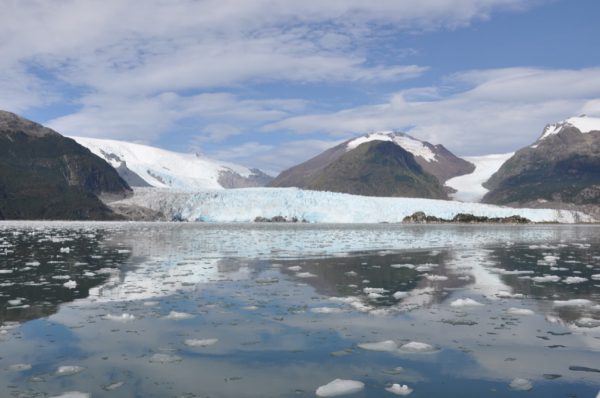
Oh, be careful what you commit to the page, ye writers! Didn’t James Cook so arrogantly reckon, after he had sailed amongst the icebergs of Antarctica and found no land, that no man would ever venture so far south again? Only a few pages earlier Tilman tells us “it is most unlikely that this long stretch of coast and its innumerable islands will ever be settled”, whereas I am likewise sure that, if mankind endures, there will inevitably be salmon farms, if not cities here. So far as the inexhaustible abundance of the Amalia glacier is concerned – we came around the corner and… Where was it?
The glacier was nowhere to be seen! And still there was no ice whatsoever. Not one teensy growler nor even an ice-cube fit for the skipper’s gin had we seen.
Whereas Tilman saw the Amalia glacier from the mouth of the inlet, we had to travel almost five miles further before it came into view. The large scale chart still shows it where Tilman saw it – but then that chart was published in 1970 and has its origins in an even older survey. The smaller scale chart dates from 1996 and puts the ice four miles further back; and the satellite image for 2013 shows it in approximately its present position, one mile beyond that.
The greater part of Amalia’s retreat is said to have occurred between 1945 and 1975, when the ice withdrew almost 270 metres every year, but it is still dwindling. Whereas the cruising guide suggests that it can be seen from the Amalia Cove, part way up the inlet, the glacier has now thinned so much that it has almost sunk below the headland at the jaw of that bay. The fact is that the supply is not inexhaustible because it is no longer being replenished. Our summers are warmer and our winters are no longer so cold, and there is less precipitation; thus, there is no more ice being made to take the place of the stuff falling off the front.
The Amalia glacier will very soon be extinct. But still, even in its dying days – even in its reduced circumstances – this river of ice is stunningly beautiful.
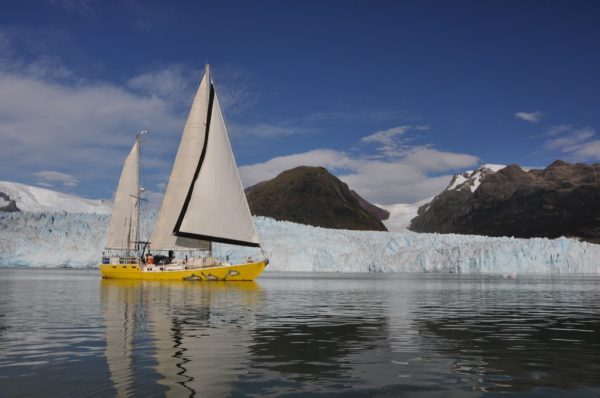
We had spent the day battling along beneath a grey sky – a matter to which we were now thoroughly accustomed, I may say, since grey skies and rain are the norm around here – but as we drew near to the glacier the clouds suddenly rolled aside and the sun sparkled down. And at this moment, just as we thought that things couldn’t get any more stupendously beautiful, we were joined by a family of Peales dolphins.
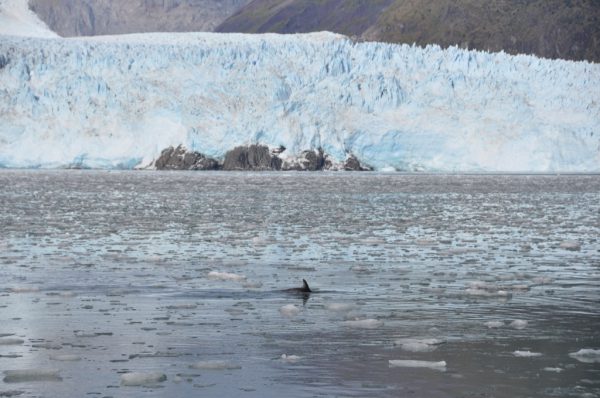
We had already stopped to photograph some Peales which came rushing to greet us as we entered the Amalia estero, and another group had visited us when we were at the place where the snout of the glacier used to be. (The 1996 chart shows somewhat shallower water here – 30 to 40 metres instead of 100 and more – and this suggests that the glacier sat here, dropping its load of silt and stones, for a very long time.)
By now we had finally reached the area of water which the glacier had strewn with ice; but the pieces of ice were small and well scattered – more like the stars adorning the sky on a clear night than the field of bergy-bits which had obstructed Tilman’s progress – and we had no qualms about pressing on. To our surprise the dolphins came too. They tacked to and fro ahead of us, surfacing amongst the shards of ice.
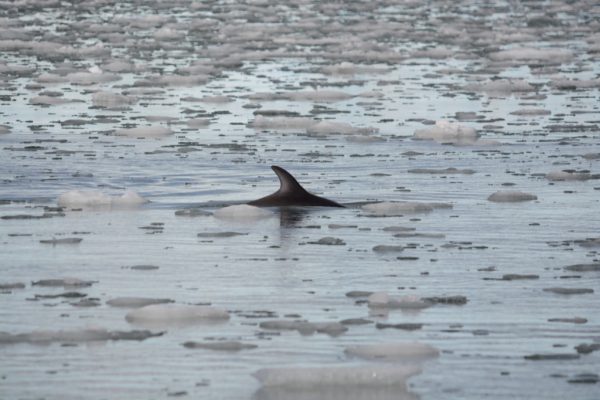
Above us the sky was brightest blue. Before us the glacier shone. It had carved two paths down to the sea, and as it slid down these valleys it was as white as could be, but where it came to the plain and came to a halt – where it was scrunched and rumpled into pinnacles, like the icing on a fancy cake – it was tinged with turquoise.
As we came closer to Amalia we could see all too clearly how she ailed. The mountain slopes on either side of us were carpeted in trees, but the trees on the bottom few hundred feet of the slopes were small – because, of course, they were very young trees.
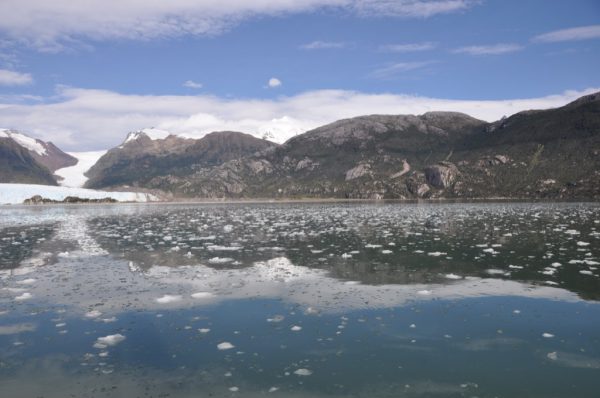
Further back, on either side of the glacier, the valleysides were red brown, which suggested that they had been even more recently exposed. The permanent snow-line in this region used to be 3,000ft, but we saw mountains more than 3,00ft high which were entirely, strikingly naked. The brown hill between the two branches of the glacier wore two little caps of ice, and it was evident that they must, until quite recently, have been part of one large mantle. And – somehow most alarming of all – the ice capping the mountain directly to the north of the snout was coated all over in rivers of red-brown dust. This must obviously accelerate its melting since, unlike pure white ice, the dust will not reflect the heat of the sun but will absorb it.
There we had it: Global warming – undeniable and irrefutable – before our very eyes.
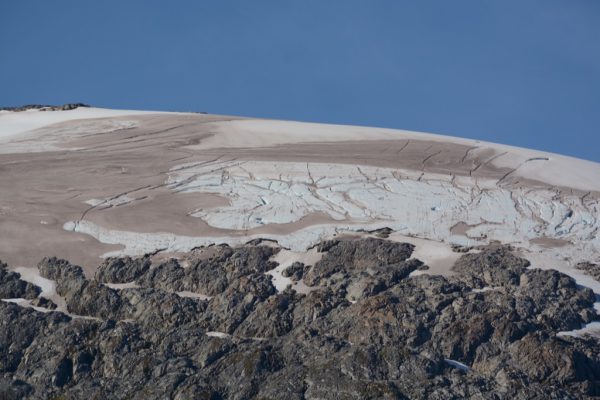
The 1996 chart shows a rock peeping out of the front of the glacier. We passed it by – it is now an islet, several hundred yards downstream from the glacier – and I cast my eyes longingly over the sand moraine which ran south from it, tying it to the shore.
“We could anchor in front of that. And then we could walk up to the glacier.”
But by now it was growing late, and that which might serve well as a daytime anchorage would not necessarily be safe to use over night.
I gazed up at the front rank of blue pinnacles. Every glacier is different and every pinnacle is different; but whereas in every other glacier that I have seen the pinnacles have all been glorious spires, these ones seemed shrivelled. The icy masses rush headlong towards the sea – like lemmings towards a cliff, or mankind towards his fate – but in the last instant, as they reach the very edge and see their death staring them in the face, the pinnacles open their mouths and eyes wide and shriek in horror. Yet not so these icy pinnacles of Amalia. Like a huddle of old women they hunched together. Their flesh had fallen away, leaving them thin and boney. Snow filled the gaps between them. They seemed dispirited and resigned to their fate.
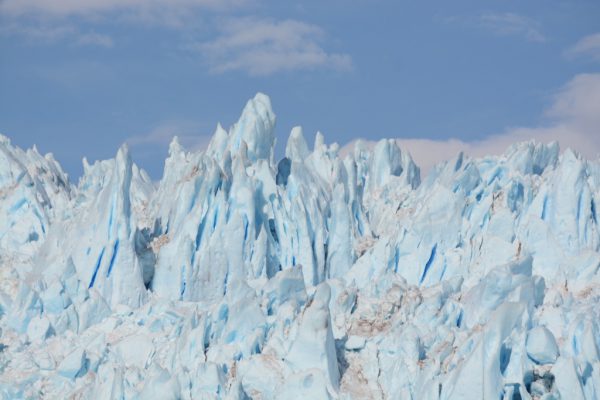
On the snowy peak astern of the glacier a small cloud hovered. The ice was not only falling into the sea, it was also dissolving into the sky.
Impermanence, before our very eyes…
Ah, but how we cling to the way things are! How we wish that these wondrous works of Nature could remain. But Nature is all the while recycling herself.
Will there ever again be anything in creation as impossibly, exquisitely, breathtakingly beautiful as a glacier?
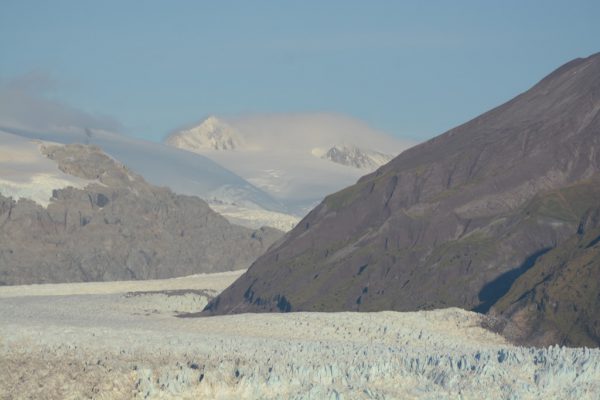
“Shall we go closer?”
But the skipper swung the bow around. “The anchorage is almost six miles away and there’s only about an hour before sunset.”
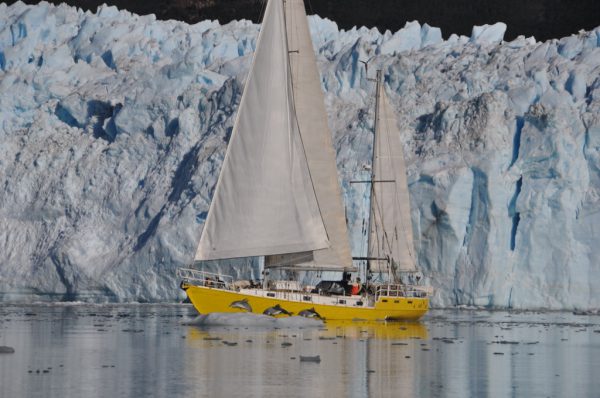
As we headed back down the inlet I tried to make sense of Tilman’s description: “A huge sheet of ice nearly two miles broad, cleft in the middle by a bald rocky hill.” The glacier is, indeed, cleft by a hill – but it is not the one of which Tilman spoke. As we have seen, in Tilman’s time that hill was six miles from the front of the glacier.
At the southern extent of the Amalia inlet, before it bends towards the glacier, there is a valley; and this valley joins the main one just a mile or so from the submarine moraine aforementioned, which marks the historic limit of the glacier. Sixty years ago, this valley also carried a river of ice down from the ice cap, and Tilman further tells us that ten years before his visit the two glaciers united after they had passed the hill and entered the sea as one. (This he knew from having studied a photograph.)
Now, the valley which this other glacier carved is forested. It has simply vanished.
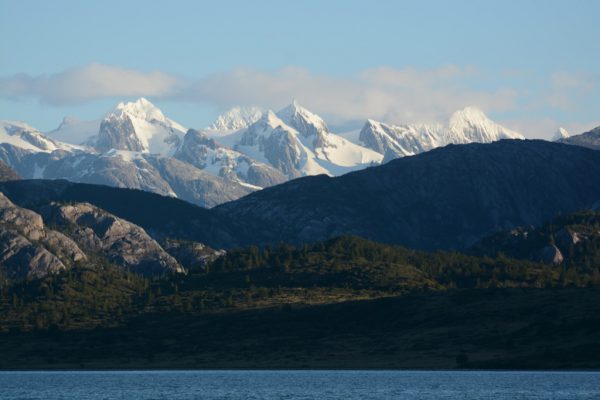
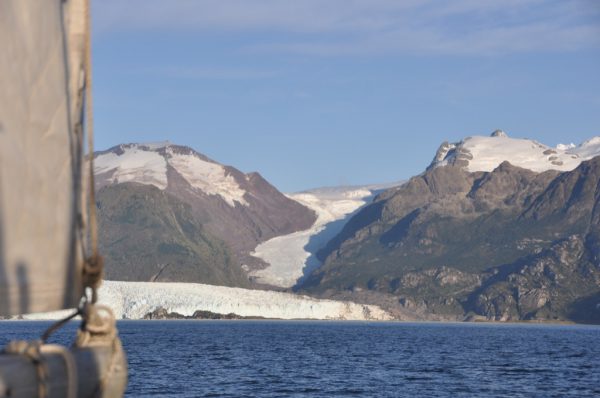
We punched our way back through the field of and entered the bay known as Caleta Amalia. Tilman also planned to anchor here, but during the time of his visit the ice was so thick that he couldn’t get near it.
For the sake of anyone planning to visit this area I should point out that the glacier does still sometimes drop impressive amounts of ice and we have heard that this cove is still sometimes inaccessible. Likewise, access to the glacier is largely at the whim of the wind. If the glacier is calving enthusiastically and the wind is simultaneously blowing hard from the north and keeping the ice in the inlet, then you might find your way blocked.
Had he known of the temperamental way of these things, Tilman might have waited for a change in the wind; but rather than wait he decided to try his luck elsewhere. The setback was severe, he tells us, but it was not necessarily fatal to his plans for the Amalia estero is just one of several arms of the Peel inlet. Since he couldn’t get close to this particular glacier he would just have to continue up the inlet and look for another one. And we, of course, were delighted to be able to follow behind him.
Join us for the next instalment!

